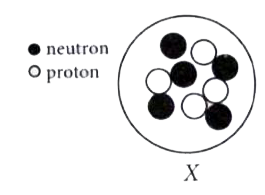The fundamental particle not present in nucleus is
electron
proton
neutron
None of these
The correct Answer is:A
To solve the question "The fundamental particle not present in nucleus is", we can follow these steps:
Step 1: Understand the Structure of an Atom
An atom consists of a nucleus at its center, which contains protons and neutrons. Electrons revolve around the nucleus in specific orbits.
Step 2: Identify the Particles
- Protons: Positively charged particles found in the nucleus.
- Neutrons: Neutral particles also found in the nucleus.
- Electrons: Negatively charged particles that orbit around the nucleus.
Step 3: Analyze the Options
The question provides four options:
- Option A: Electron
- Option B: Proton
- Option C: Neutron
- Option D: None of these
Step 4: Determine Which Particle is Not in the Nucleus
From our understanding:
- Protons and neutrons are present in the nucleus.
- Electrons are not present in the nucleus; they exist in the space surrounding the nucleus.
Step 5: Conclusion
Based on the analysis, the fundamental particle that is not present in the nucleus is Option A: Electron.
Final Answer:
The fundamental particle not present in the nucleus is Electron.
---
An atom consists of a nucleus at its center, which contains protons and neutrons. Electrons revolve around the nucleus in specific orbits.
- Protons: Positively charged particles found in the nucleus.
- Neutrons: Neutral particles also found in the nucleus.
- Electrons: Negatively charged particles that orbit around the nucleus.
The question provides four options:
- Option A: Electron
- Option B: Proton
- Option C: Neutron
- Option D: None of these
From our understanding:
- Protons and neutrons are present in the nucleus.
- Electrons are not present in the nucleus; they exist in the space surrounding the nucleus.
Based on the analysis, the fundamental particle that is not present in the nucleus is Option A: Electron.
The fundamental particle not present in the nucleus is Electron.
Topper's Solved these Questions
- BOOK - ARIHANT PUBLICATION JHARKHANDCHAPTER - AMMONIA , SULPHUR DIOXIDE, HYDROGEN SULPHIDE AND HYDROGEN CHLORIDEEXERCISE - EXAM BOOSTER FOR CRACKING EXAM77videos
AMMONIA , SULPHUR DIOXIDE, HYDROGEN SULPHIDE AND HYDROGEN CHLORIDE
- BOOK - ARIHANT PUBLICATION JHARKHANDCHAPTER - CATALYSISEXERCISE - EXAM BOOSTER FOR CRACKING EXAM25videos
CATALYSIS
Similar Questions
Knowledge Check
- Question 1 - Select One
The fundamental particles not present in the nucleus of hydrogen atom is
AelectronBprotonCneutronDnone of these - Question 2 - Select One
Which is the fundamental particle not present in the nucleus of hydrogen atom?
AelectronBprotonCneutronDNone of these - Question 3 - Select One
The fundamental particles present in equal numbers in neutral atoms (atomic number 71) are
Aprotons and electronsBneutrons and electronsCProtons and neutronsDprotons and positrons
Which one of the three fundamental particles is present in the cathode rays ?
View SolutionName the fundamental particles present in an atom.
View SolutionThe diagram given below shows the sub-atomic particles present in the nucleus of atom X.

Which is the symbol for atom X ?View SolutionThe nucleoprotein present in nucleus is
View SolutionNucleus is not present in
View Solution

